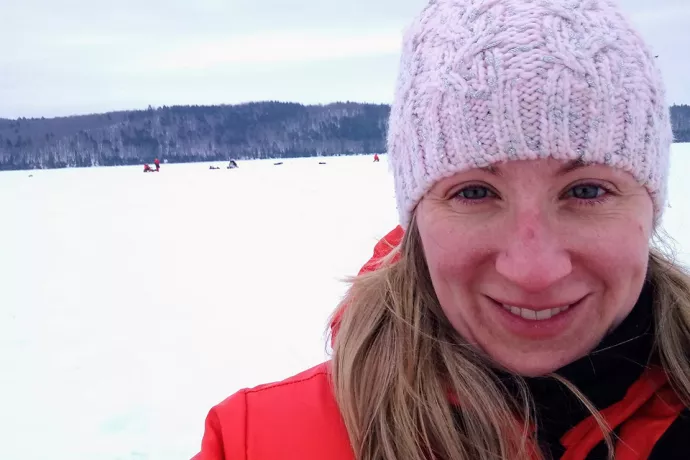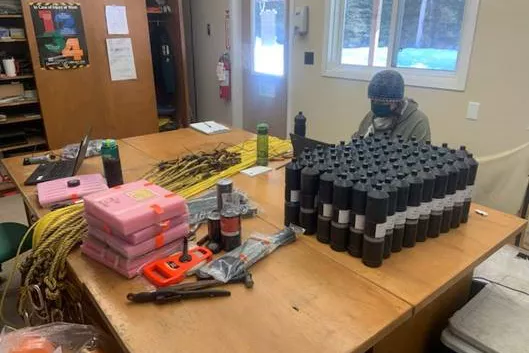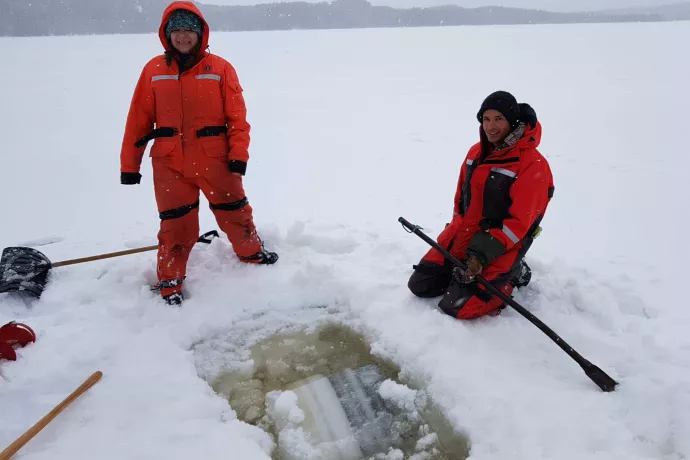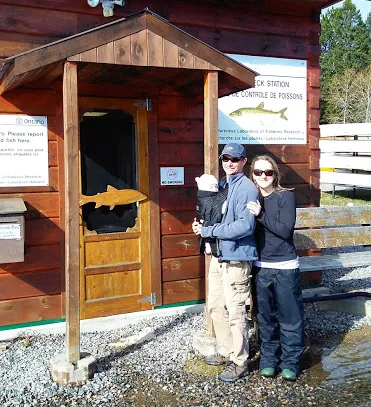
UTM biologist expands study of climate change risk to Algonquin Park fish
UTM biology professor Bailey McMeans will be wading deeper into the secret lives of Algonquin Park fish, thanks to a Natural Sciences and Engineering Research Council of Canada grant.
“We’ve had a rapid flurry of activity since we received the grant in November,” says McMeans. “We got all of our permits approved and purchased a bunch of equipment, which the field crew is going to start deploying next week.”
The aquatic ecologist and her team have spent the last few years studying the effects of seasonality and ice-covered winter freshwater fish at the Harkness Laboratory of Fisheries Research in Ontario’s Algonquin Provincial Park.
The team hopes their data will help adapt stocking and harvest limits to better protect fish in the face of climate change.
Their most recent data revealed, for the first time, that fish behaviour in winter is radically different from that observed during the summer months.
The new $462,000 Alliance grant is the first for University of Toronto under NSERC’s new Option 2 program, which encourages university researchers to collaborate with organizations from the private, public or not-for-profit sectors — in this case Ontario’s Ministry of Natural Resources and Forestry.

In addition to more equipment, the funds will support five graduate students and a summer crew of undergrads and members of the Algonquins of Ontario Indigenous community, allowing the study to expand to include more fish and larger lakes.
“We think lake size might be really important to the amount of new fish biomass produced every year,” says McMeans. “That’s a really key metric for fisheries managers because the more productive the fish population is, the more that can be harvested and the more recreational fishing it can support without risking collapsing the population.”
The team is electronically tagging 20 fish of each species - lake trout, burbot, white suckers and small mouth bass – at a cost of $850 per tag. The tags will ping 86 new acoustic receivers affixed to the lakebed to record each fish’s position.
The Real-Time Aquatic Ecosystem Observation Network has also made an in-kind donation to record the temperature of the lakes.
“We never could have done this on this budget without all the cool stuff people have given us,” says McMeans.
The grant also allows the team to expand the length of the study.
“In the five years we are probably going to be able to capture warm summers, cold summers, short winters, long winters and see in real time how multiple species in a community respond to that,” McMeans says. “We can then connect those behaviours directly with production, to better predict how climate change will affect freshwater fish.”
A group of skilled scientists provide the “backbone” of the work, she continues.
McMeans’ co-principal investigators include University of Windsor’s Aaron Fisk, UTSC’s Mathew Wells, Queen’s University’s Paul Blanchfield and University of Guelph’s Kevin McCann. Other collaborators include Tyler Tunney of Fisheries and Oceans Canada and Mark Ridgway, director of the Harkness Laboratory for Fisheries Research, which is collecting the data.

McMeans and her fellow researchers are deploying their acoustic telemetry arrays in three lakes: Canoe, Tea and Smoke.
“These will be very familiar to anyone who has been to Algonquin Park,” she says.
Popular with canoeists, swimmers and fishermen, the team has taken precautions to try to keep their subjects in the lakes for the duration of the study.
“The (internally tagged) fish will also be marked with an external tag,” McMeans says. “There will be public information asking people, ‘If you catch one of these, please let it go because it’s part of a scientific study.’”
Family trips to Algonquin Park
Originally from Nashville, McMeans began her undergraduate work in biology at Middle Tennessee State University with an eye toward medical school.

A field course on Vancouver Island during her third year of biology “changed everything,” McMeans says. “I bailed on medical school because I realized I didn’t want to spend my life in a hospital – I wanted to be outside studying the natural world.”
She set her sights on aquatic ecology.
“As a graduate student I worked in the Arctic, which was great, but so hard,” she says of a study that saw her travelling from Nunavut to Norway, tracking Greenland sharks. “It’s so far away, it takes so long to get there and you have to ship your samples back.”
After her daughter Darby was born in 2016, McMeans sought a field site that was closer to home. In 2017, she joined the faculty at UTM, teaching undergraduate marine ecology and field methods, and shifted her research to Algonquin Park.
With her new study area just a four hour drive from her home in Guelph, McMeans visits the sites once a season and the research has even become a family outing for McMeans and her husband, and — of course — Darby.
“She’s been up there every summer of her life, except this last one because of COVID,” says McMeans.
And, she adds, Darby’s become an excellent junior crew member, literally following in her mother’s footsteps.
“She helps with stuff like shoreside sampling for macroinvertebrates, where you go out in the water and kick your feet and sweep the net,” she says. “She just loves feeding the fish.”
Read more:
